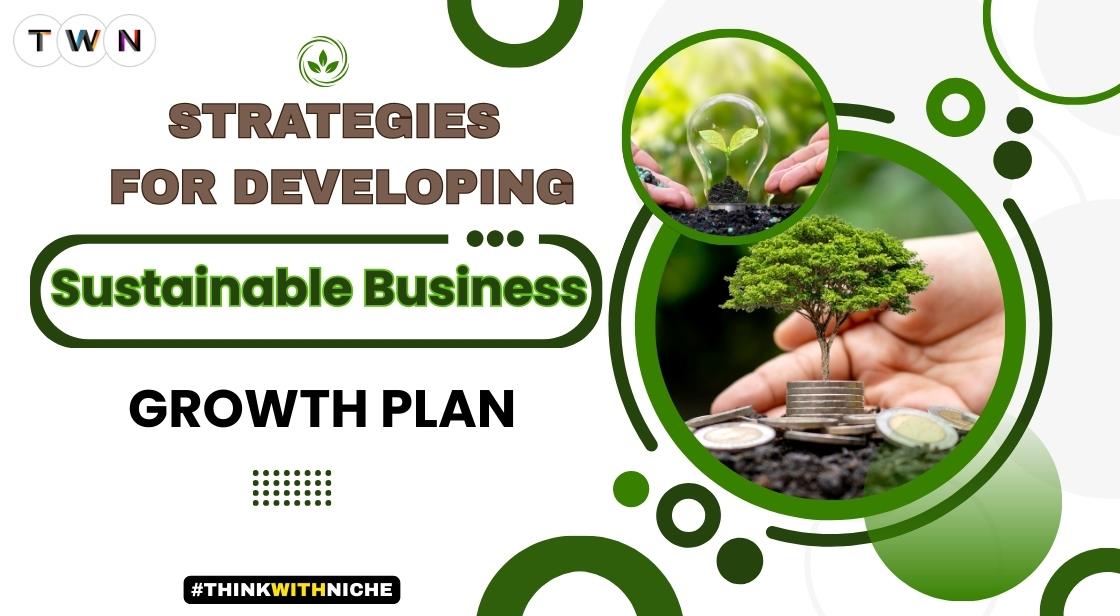Strategies for Developing a Sustainable Business Growth Plan

Blog Post
In today’s rapidly changing business landscape, organizations are increasingly recognizing the necessity of integrating sustainability into their growth strategies.
Sustainable business growth is not merely a trend; it is a fundamental shift in how companies operate, focusing on expanding profits while ensuring the health of social and environmental ecosystems.
This approach advocates for a balanced perspective, emphasizing the importance of economic performance alongside social equity and environmental stewardship.
As consumers become more environmentally conscious, businesses must adapt to meet their expectations. This entails developing a sustainable growth plan that encompasses economic, social, and environmental factors, fostering long-term viability and resilience.
By aligning business practices with sustainability principles, companies can create value not only for themselves but also for society and the planet.
In this article, we will explore essential tips for designing a sustainable growth plan, beginning with a clear definition of sustainable business growth.
We will delve into the importance of balancing economic, social, and environmental factors, understand the components of sustainability, and highlight the benefits of pursuing a sustainable growth trajectory.
Additionally, we will outline key steps for creating an effective sustainable business growth plan, offering actionable insights to help organizations navigate challenges and seize opportunities in their sustainability journey.
By embracing these strategies, businesses can position themselves for long-term success while contributing positively to the world around them.
Tips for Designing a Sustainable Growth Plan for Your Business
Definition of Sustainable Business Growth
Sustainable business growth refers to the ability of a company to expand its operations and profits while ensuring that its practices do not deplete resources or harm social and environmental ecosystems. It emphasizes the importance of maintaining a balance between financial performance and the well-being of society and the environment. This approach advocates for a long-term perspective, integrating sustainability into core business strategies rather than treating it as an afterthought.
Importance of Balancing Economic, Social, and Environmental Factors
In today’s competitive landscape, businesses must recognize the interconnectedness of economic, social, and environmental factors. Economic growth should not come at the expense of social equity or environmental health. Companies that successfully balance these elements can achieve long-lasting success, attract socially conscious consumers, and mitigate risks associated with environmental regulations and market fluctuations. For instance, investing in sustainable practices can lead to cost savings, improved brand reputation, and increased customer loyalty.
Understanding Sustainable Business Growth
Sustainable business growth refers to the ability of a company to develop and expand its operations while ensuring long-term viability without compromising its ethical, social, and environmental responsibilities. This approach not only focuses on profitability but also considers the broader impact of business activities on society and the planet.
Components of Sustainability
Economic Sustainability
Economic sustainability emphasizes the importance of profitability and financial health for a business. It involves creating value through effective resource management, cost control, and innovation. A financially sustainable business can invest in growth opportunities, weather economic downturns, and provide returns to shareholders, ensuring its continued success in the market.
Social Sustainability
Social sustainability focuses on the impact a business has on its employees, customers, and the communities in which it operates. This includes promoting fair labor practices, ensuring employee well-being, and engaging with local communities to address their needs. By fostering a positive social environment, businesses can enhance employee morale, attract top talent, and build strong customer loyalty.
Environmental Sustainability
Environmental sustainability aims to minimize a company’s ecological footprint by reducing waste, conserving resources, and promoting eco-friendly practices. This includes adopting renewable energy sources, improving energy efficiency, and implementing sustainable supply chain practices. By prioritizing environmental sustainability, businesses can contribute to the health of the planet while also appealing to environmentally conscious consumers.
Benefits of Sustainable Growth
Long-term Viability and Competitive Advantage
Sustainable growth ensures that businesses remain viable over the long term by aligning their strategies with evolving market demands and societal values. Companies that prioritize sustainability often gain a competitive edge as they adapt to consumer preferences for responsible products and services.
Enhanced Brand Reputation and Customer Loyalty
Embracing sustainable practices enhances a company’s brand reputation, attracting customers who value ethical and responsible business conduct. This positive perception fosters customer loyalty, resulting in repeat business and advocacy.
Compliance with Regulations and Reduced Risks
As regulations around environmental and social responsibility tighten, businesses that proactively implement sustainable practices are better positioned to comply with these requirements. This not only mitigates legal risks but also enhances operational resilience in the face of regulatory changes.
Steps to Create a Sustainable Business Growth Plan
Creating a sustainable business growth plan is essential for organizations seeking long-term success while minimizing their environmental impact. This article outlines the key steps involved in developing such a plan, ensuring businesses can navigate challenges and embrace opportunities that promote sustainability.
Conduct a SWOT Analysis
Identifying Strengths, Weaknesses, Opportunities, and Threats
The first step in formulating a sustainable business growth plan is conducting a SWOT analysis. This process involves identifying the internal strengths and weaknesses of your organization and assessing external opportunities and threats in the market. Strengths may include robust financial performance, innovative products, or a loyal customer base, while weaknesses might involve limited resources or lack of expertise in sustainable practices.
When assessing opportunities, consider market trends favoring sustainability, such as increasing consumer demand for eco-friendly products. Threats could stem from regulatory changes or competitive pressure from other companies adopting sustainable practices. This comprehensive analysis provides a foundational understanding of where your business stands in terms of sustainability and helps inform future strategies.
Define Clear Goals and Objectives
Setting SMART Goals
Once the SWOT analysis is complete, the next step is to define clear goals and objectives for your sustainable business growth plan. It is essential to set SMART (Specific, Measurable, Achievable, Relevant, and Time-bound) goals that align with your organization's sustainability aspirations. For example, a specific goal might be to reduce carbon emissions by 20% within three years.
Aligning these objectives with sustainable practices ensures that every target contributes to the broader mission of promoting sustainability. This alignment not only enhances accountability but also motivates employees and stakeholders to work towards common goals.
Understand Your Market and Customers
Researching Market Trends and Customer Preferences
Understanding market dynamics and customer preferences is crucial for developing a sustainable growth strategy. Conduct thorough research on current market trends, focusing on consumer demand for sustainable products and services. Analyze competitor offerings and identify gaps that your business can fill.
Engaging with customers is equally important. Surveys, interviews, and feedback sessions can provide valuable insights into customers' values and expectations regarding sustainability. This understanding enables businesses to tailor their offerings and marketing strategies to meet the needs of environmentally conscious consumers, fostering brand loyalty and trust.
Develop a Value Proposition
Articulating Your Business’s Contribution to Sustainability
A well-defined value proposition is critical for communicating how your business contributes to sustainability. Articulate the unique benefits your products or services provide in terms of environmental impact. For example, if your company uses recycled materials or supports renewable energy initiatives, highlight these aspects in your marketing efforts.
Your value proposition should resonate with environmentally conscious consumers, emphasizing how choosing your brand supports their sustainability goals. By clearly communicating your commitment to sustainable practices, you can differentiate your business from competitors and attract a loyal customer base.
Create an Action Plan
Outlining Strategies and Initiatives
The next step involves creating a detailed action plan that outlines specific strategies and initiatives for achieving sustainable growth. This plan should include clear timelines for implementation, resources required, and key performance indicators (KPIs) to measure success.
For instance, if one of your goals is to reduce waste, outline the steps needed to achieve this, such as implementing recycling programs or optimizing production processes. Assign responsibilities to team members and establish a timeline for monitoring progress. This structured approach ensures accountability and helps keep the team focused on sustainability objectives.
Incorporate Sustainable Practices
Reducing Waste and Minimizing Environmental Impact
Incorporating sustainable practices into your business operations is vital for achieving long-term growth. Identify areas where you can reduce waste, conserve resources, and minimize your environmental impact. This might involve transitioning to energy-efficient technologies, optimizing supply chains, or adopting eco-friendly packaging.
Additionally, consider implementing ethical sourcing practices to ensure that your materials come from sustainable and responsible suppliers. By integrating these practices into your business model, you not only contribute to environmental sustainability but also enhance your brand reputation and appeal to conscious consumers.
Engage Stakeholders
Collaborating with Employees, Customers, and Communities
Engaging stakeholders is a critical component of a sustainable business growth plan. Collaborate with employees, customers, suppliers, and the broader community to foster a culture of sustainability within your organization. Encourage employees to participate in sustainability initiatives and provide training to enhance their understanding of sustainable practices.
Engaging customers through sustainability-focused campaigns or community initiatives can also strengthen relationships and build brand loyalty. By actively involving stakeholders in your sustainability journey, you create a sense of shared responsibility and commitment to achieving your goals.
Monitor and Evaluate Progress
Tracking Performance Against Goals
Establishing mechanisms for monitoring and evaluating progress is essential for ensuring the success of your sustainable business growth plan. Regularly review your performance against the defined KPIs and assess whether you are on track to achieve your sustainability objectives.
Be open to adjusting your plan based on feedback, changing market conditions, or new opportunities that arise. This adaptability allows your business to remain responsive and innovative in the face of evolving sustainability challenges and trends.
Challenges to Sustainable Growth
Sustainable business growth often faces various challenges that can hinder a company’s ability to implement effective strategies. Understanding these obstacles and how to overcome them is crucial for any organization aiming to adopt sustainable practices.
Common Obstacles
-
Financial Constraints and Short-Term Pressures
-
Many businesses prioritize immediate financial performance over long-term sustainability. Limited budgets can make it difficult to invest in sustainable initiatives, as companies may perceive these efforts as cost burdens rather than opportunities for growth. Additionally, shareholders often pressure management to focus on short-term profits, leaving little room for sustainable investments.
-
-
Resistance to Change Within the Organization
-
Change can be challenging in any organization, and sustainability initiatives may face pushback from employees who are accustomed to traditional practices. This resistance can stem from a lack of understanding of sustainability’s importance or fear of the unknown. Overcoming this inertia requires effective change management strategies to align the workforce with new sustainable goals.
-
-
Complexity of Integrating Sustainability into Existing Business Models
-
Integrating sustainability into established business models often involves reevaluating processes, supply chains, and operational frameworks. This complexity can create confusion and reluctance among employees and management alike. Additionally, aligning sustainability efforts with existing strategies can require significant resources and time.
-
Overcoming Challenges
-
Emphasizing the Long-Term Benefits of Sustainable Practices
-
Communicating the long-term benefits of sustainability, such as cost savings from energy efficiency, improved brand reputation, and enhanced customer loyalty, can help shift the focus from short-term pressures. Demonstrating how sustainable practices contribute to the company's overall success can garner support from stakeholders.
-
-
Providing Training and Resources to Support Employees
-
Equipping employees with the necessary training and resources is vital for fostering a culture of sustainability. This includes workshops, seminars, and access to tools that enhance understanding and implementation of sustainable practices.
-
-
Engaging Leadership in Championing Sustainability Initiatives
-
Leadership plays a critical role in promoting sustainability within an organization. By actively championing sustainability initiatives, leaders can inspire employees and create a shared vision that aligns with the company's values. This commitment can help overcome resistance and drive sustainable growth.
-
By recognizing and addressing these challenges, businesses can pave the way for effective sustainable growth strategies.
In conclusion,
creating a sustainable business growth plan requires balancing economic, social, and environmental factors. By adopting long-term strategies, integrating sustainable practices, and engaging stakeholders, businesses can achieve lasting success. Overcoming challenges with innovation and leadership will position companies for future growth while contributing positively to society and the planet.
You May Like
EDITOR’S CHOICE












